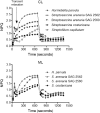Light and Dehydration but Not Temperature Drive Photosynthetic Adaptations of Basal Streptophytes (Hormidiella, Streptosarcina and Streptofilum) Living in Terrestrial Habitats
- PMID: 29974184
- PMCID: PMC6394494
- DOI: 10.1007/s00248-018-1225-x
Light and Dehydration but Not Temperature Drive Photosynthetic Adaptations of Basal Streptophytes (Hormidiella, Streptosarcina and Streptofilum) Living in Terrestrial Habitats
Abstract
Streptophyte algae are the ancestors of land plants, and several classes contain taxa that are adapted to an aero-terrestrial lifestyle. In this study, four basal terrestrial streptophytes from the class Klebsormidiophyceae, including Hormidiella parvula; two species of the newly described genus Streptosarcina (S. costaricana and S. arenaria); and the newly described Streptofilum capillatum were investigated for their responses to radiation, desiccation and temperature stress conditions. All the strains showed low-light adaptation (Ik < 70 μmol photons m-2 s-1) but differed in photoprotective capacities (such as non-photochemical quenching). Acclimation to enhanced photon fluence rates (160 μmol photons m-2 s-1) increased photosynthetic performance in H. parvula and S. costaricana but not in S. arenaria, showing that low-light adaptation is a constitutive trait for S. arenaria. This lower-light adaptation of S. arenaria was coupled with a higher desiccation tolerance, providing further evidence that dehydration is a selective force shaping species occurrence in low light. For protection against ultraviolet radiation, all species synthesised and accumulated different amounts of mycosporine-like amino acids (MAAs). Biochemically, MAAs synthesised by Hormidiella and Streptosarcina were similar to MAAs from closely related Klebsormidium spp. but differed in retention time and spectral characteristics in S. capillatum. Unlike the different radiation and dehydration tolerances, Hormidiella, Streptosarcina and Streptofilum displayed preferences for similar thermal conditions. These species showed a temperature dependence of photosynthesis similar to respiration, contrasting with Klebsormidium spp. and highlighting an interspecific diversity in thermal requirements, which could regulate species distributions under temperature changes.
Keywords: Acclimation; Desiccation; Green algae; Photoprotection; Streptophyta; Temperature.
Figures





Similar articles
-
New Taxa of Streptophyte Algae (Streptophyta) from Terrestrial Habitats Revealed Using an Integrative Approach.Protist. 2018 Jul;169(3):406-431. doi: 10.1016/j.protis.2018.03.002. Epub 2018 Mar 20. Protist. 2018. PMID: 29860113 Free PMC article.
-
Entransia and Hormidiella, sister lineages of Klebsormidium (Streptophyta), respond differently to light, temperature, and desiccation stress.Protoplasma. 2016 Sep;253(5):1309-23. doi: 10.1007/s00709-015-0889-z. Epub 2015 Oct 6. Protoplasma. 2016. PMID: 26439247 Free PMC article.
-
Living in biological soil crust communities of African deserts-Physiological traits of green algal Klebsormidium species (Streptophyta) to cope with desiccation, light and temperature gradients.J Plant Physiol. 2016 May 1;194:2-12. doi: 10.1016/j.jplph.2015.09.002. Epub 2015 Sep 9. J Plant Physiol. 2016. PMID: 26422081 Free PMC article.
-
Desiccation tolerance in streptophyte algae and the algae to land plant transition: evolution of LEA and MIP protein families within the Viridiplantae.J Exp Bot. 2020 Jun 11;71(11):3270-3278. doi: 10.1093/jxb/eraa105. J Exp Bot. 2020. PMID: 32107542 Free PMC article. Review.
-
Photosynthetic adaptation to polar life: Energy balance, photoprotection and genetic redundancy.J Plant Physiol. 2022 Jan;268:153557. doi: 10.1016/j.jplph.2021.153557. Epub 2021 Nov 13. J Plant Physiol. 2022. PMID: 34922115 Review.
Cited by
-
Trophic state alters the mechanism whereby energetic coupling between photosynthesis and respiration occurs in Euglena gracilis.New Phytol. 2021 Nov;232(4):1603-1617. doi: 10.1111/nph.17677. Epub 2021 Sep 1. New Phytol. 2021. PMID: 34392544 Free PMC article.
-
Plant terrestrialization: an environmental pull on the evolution of multi-sourced streptophyte phenolics.Philos Trans R Soc Lond B Biol Sci. 2024 Nov 18;379(1914):20230358. doi: 10.1098/rstb.2023.0358. Epub 2024 Sep 30. Philos Trans R Soc Lond B Biol Sci. 2024. PMID: 39343031 Free PMC article. Review.
-
Photosynthesis, Respiration, and Growth of Five Benthic Diatom Strains as a Function of Intermixing Processes of Coastal Peatlands with the Baltic Sea.Microorganisms. 2022 Mar 30;10(4):749. doi: 10.3390/microorganisms10040749. Microorganisms. 2022. PMID: 35456804 Free PMC article.
-
Phylogenomic insights into the first multicellular streptophyte.Curr Biol. 2024 Feb 5;34(3):670-681.e7. doi: 10.1016/j.cub.2023.12.070. Epub 2024 Jan 19. Curr Biol. 2024. PMID: 38244543 Free PMC article.
-
Evo-physio: on stress responses and the earliest land plants.J Exp Bot. 2020 Jun 11;71(11):3254-3269. doi: 10.1093/jxb/eraa007. J Exp Bot. 2020. PMID: 31922568 Free PMC article.
References
-
- Leliaert F, Smith DR, Moreau H, Herron MD, Verbruggen H, Delwiche CF, De Clerck O. Phylogeny and molecular evolution of the green algae. Crit Rev Plant Sci. 2012;31:1–46. doi: 10.1080/07352689.2011.615705. - DOI
MeSH terms
Substances
Grants and funding
LinkOut - more resources
Full Text Sources
Other Literature Sources
Miscellaneous

